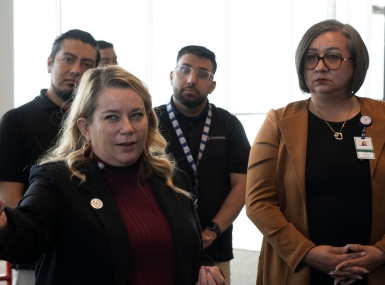North Dakota to take over social service funding for counties

North Dakota will fund social services for two years, taking the load off of counties
Counties in North Dakota have a two-year reprieve from managing and paying for social services while the state takes over in a pilot program.
The state will fund county social services in 2018 and 2019, to the tune of $160.7 million, and in the process, reduce property taxes by 6 percent. It’s the culmination of what North Dakota Association of Counties Executive Director Mark Johnson described as a 14-year battle. A similar bill nearly passed the Legislature in 2015.
As social service costs increased, so did the stress on property tax, which was essentially counties’ only funding source for the services.
“We’ve chipped away at the financial responsibilities over time, we used to pay part of them,” said Terry Traynor, NDACo’s assistant director of policy and programs. “It just got to be more and more difficult. It was difficult that counties with the highest costs were those with the lowest property taxes.”
The program should particularly help counties with larger masses of untaxable land, owned either by the federal government or tribes.
“From our perspective, those counties that are getting more property tax relief have been paying more than their fair share of social services for more than 40 years,” Traynor said.
That 6 percent property tax reduction will coincide with the state’s elimination of a six-year, 12 percent property tax buydown, made possible by the oil boom in western North Dakota. In the years since the buydown was introduced, however, oil prices have dropped, making it hard for the state to continue funding it.
Wells County Commissioner Randi Suckut said the shift in responsibility would lighten tensions in his county. The state- and federally-mandated services carried with them salaries that were out of line with what the county could offer for other workers. In Wells County, those offices are across the street from each other.
“Social services workers would get a 3–4-percent increase, meanwhile other county workers they would get 1 percent and they’d ask why do they get that,” he said. “Our hands were tied there, but they aren’t anymore. We won’t have the state telling us what we had to do with people who were supposedly our employees.”
He also says it is an easier sell to constituents.
“We can explain to them why taxes go up when it has to do with roads or sheriffs, but social services was such a disconnect because we didn’t have the control over what we did,” he said.
Dunn County Commissioner Daryl Dukart said the change in responsibility could help benchmark how services are provided.
“It’s going to become a correction point for the way state and federal organizations are run in our state,” he said. “The goal is that we become more efficient and not lose the ability to serve everyone who needs it.”
Traynor said there is some concern that the pilot program may end with the state’s deciding to take social services to a regional delivery system, which would dilute county influence over how the services are provided. Iowa recently transitioned to a regional system for mental health services.
“We still feel like counties can make the best decisions about how the services can be provided in our communities,” Traynor said.
Iowa still feeling out mental health realignment
Four years after Iowa’s 99-county mental health systems formed 14 regions, outdated funding plans have limited their ability to change their services.
Unlike North Dakota’s social services transfer, Iowa’s regional systems still use county property tax revenue to fund non-Medicaid mental health services. Those property tax rates, however, remain from 1996, and a funding increase was not part of the realignment.
In that time, said Bill Peterson, executive director of the Iowa State Association of Counties, the urban migration within the state has left rural areas subsidizing urban areas.
“What needs to happen is they need to take off the regional dollar caps, let regions set their own expenditure limits,” Peterson said. “The funding is inadequate for those regions to do the things they are expected to do, like create new programs for crisis stabilization and jail diversion options.”
At the same time that regionalization kicked off, the state took over Medicaid-funded services, which Peterson said has removed an important layer of management that counties once provided, one that the managed care providers hired to handle the job haven’t maintained.
“Counties managed the services better than the state,” he said. “They were better at matching individuals with services in an efficient manner and controlling expenses.”
Administratively, however, Peterson said the regionalization has been successful.
“Many regions have just reorganized the county staff that were providing these services before, so there is continuity there,” he said.”
Attachments
Related News

El Paso County, Texas helps migrants on their way
Though they don't often stay more than a day, asylum seekers receive care and services from El Paso County, Texas before they leave for their next destination.

L.A. County fends off homelessness with an assist from A.I.
A predictive model pulls data from six county departments to create a list of the county’s most vulnerable population — people who frequently show up in the county’s criminal justice and hospital systems and who access benefits like SNAP.

